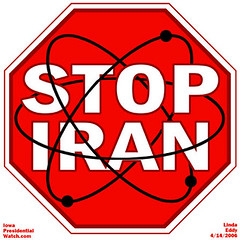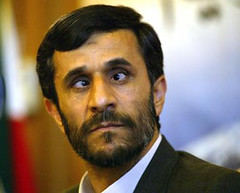Sunday, August 06, 2006
Defense & Foreign Affairs - August 01
Founded in 1972. Formerly Defense & Foreign Affairs Daily.
Volume XXIV, No. 45 Tuesday, August 1, 2006
Psychological Strategy - Iran Continues Escalation of War With Israel, Constraining Israeli Strategic Freedom of Action
Analysis. By Gregory R. Copley, Editor, GIS.
Iranian and Israeli strategic planners are working on the assumption that there is a fairly rigid and predictable escalatory pattern to their mutual conflict, leading ultimately to a confrontation with strategic weapons. It is now clear that each is aware that the onus is on Israel to circumvent the “inevitable” step-by-step process leading to nuclear and biological weapons exchanges, and that Iran must attempt to anticipate and neutralize Israel’s planned circumvention of the process.
Tehran envisages a step-by-step escalation which could be played out within the month of August 2006, a timetable which is linked to Iran’s ostensible commitment to reply to the United Nations on its nuclear programs by August 22, 2006, a date carefully selected by the Iranian Government.
Iran must limit, and even paralyze, Israel’s ability to respond to the attacks against it and Iran — with a long historical experience working in the Balkans with the Bosnian Islamist Government during the wars of the 1990s — recognizes that international public/political opinion and pressure are likely to be the principal factor inhibiting Israeli strategic freedom of action.
There is, within Iranian and Islamist circles, a strong awareness, for example, that the February 5, 1994, Muslim stage-managed explosion at the Markale Marketplace in Sarajevo, Bosnia, effectively ended all Serbian freedom of political and military action, ultimately leading to the defeat of the Serbs in that conflict.
The tactic of stage-managed “attacks” on Muslim civilian targets was something which was repeated by Muslim military leaders throughout the wars involving the break-up of the former Yugoslavia, but it was also used on June 9, 2006, in a bombing in which eight Palestinians were killed and at least 30 others were injured in an explosion at a beach near the municipality of Beit Lahia in the Gaza Strip.
The HAMAS leadership at that time blamed the incident on Israeli shelling, which was, in fact, technically infeasible; the incident was stage-managed by HAMAS to bring down international public opinion against Israel.
Similarly, the current Iranian-controlled HizbAllah/Syrian phase of the conflict with Israel has attempted to use international public opinion to successfully constrain Israeli military actions which had been making strong headway against the 15,000 to 20,000 missile launchers and their associated forces in Southern Lebanon.
The deaths of some 60 Lebanese civilians at Qana, in the Lebanese area adjacent to the Israeli border, on July 30, 2006, were used as a major political lever on the international community to pressure Israel into curtailing its military operations against the HizbAllah and Iranian Pasdaran missile forces.
The US Government, unable to withstand the media images of the deaths at Qana, put massive pressure on Israel to declare a unilateral cessation of air strikes in the area for 48 hours, giving HizbAllah and the Pasdaran and Syrian forces time to consolidate and re-group. Moreover, the US pressure represents the “thin end of the wedge” to ensure that international public and political opinion remains firmly against Israel in the conflict which was very pointedly initiated by Tehran.
It may be that the civilian deaths were the result of the Israeli air strikes against missile launchers located very deliberately within civilian residential areas of Qana, following the typical HizbAllah/HAMAS patterns of using human shields comprised of their own civilian populations.
However, there are a number of discrepancies emerging in the “Qana affair”, including the fact that the explosions which killed the 60 or so civilians seem to have occurred as much as seven hours after the Israeli air raid, and the fact that some of the photographs of the “humanitarian relief work” after the incident appeared to have been carefully staged and inconsistent in terms of timeline and other factors.
But whether the Qana affair turns out to be the result of the Israeli Air Force attacks on legitimate missile targets illegitimately placed within civilian areas or whether the affair was stage-managed, it is clear that the Iranian-controlled exploitation of the event moved rapidly and effectively into action, and achieved a pivotal turning point in Israel’s ability to respond to the war initiated through HizbAllah and HAMAS by Iran.
It is unlikely, however, that the Iranian leadership would expect Israel to allow itself to be constrained from real military action should the threat from Tehran (via its proxies at this point) escalate substantially, but a theater-level advantage was gained by the Qana affair for Iran.
Anticipated Framework of Escalation
Iran has, since the Israeli military withdrawal from Southern Lebanon in May 2000, built a multi-tiered and highly-capable network of forces, using HizbAllah combatants and uniformed Iranian Revolutionary Guard Corps (IRGC: Pasdaran) personnel in the area, equipped with a broad array of rockets and missiles capable of reaching into Israel as far as Tel Aviv and beyond.
Note: Tehran maneuvers for a wider war with Israel to ensure that the US-led war on Iraq does not leave Iran isolated and surrounded.
That force, quite apart from Syrian-based units, had a force structure which included some 15,000 to 20,000 rockets and missiles by the time the current fighting was triggered. Israel has claimed publicly that a significant proportion of this force had been destroyed by July 31, 2006, but this was believed to have been a statement made for public consumption, to allay concerns about the future attacks on Israeli civilian targets.
Indeed, it was also believed that the statement was made at the insistence of the US, which wants to demonstrate that Israel may have achieved its stated goal of destroying the HizbAllah infrastructure in Lebanon, thus enabling Israel to “declare victory and go home”.
While the attacks certainly limited the Iranian-controlled capabilities in Southern Lebanon — perhaps even more rapidly degrading them than Tehran anticipated — it is clear that the force remains in place to essentially commence the escalation planned by Tehran. That escalation includes the creation of considerable chaos in Israel through saturation attacks on civilian targets, a point not yet commenced by the HizbAllah and Pasdaran forces.
It may have been considered, when the build-up began in 2000-2001, that the southern Lebanon-based missiles could be used with some suddenness to cause Israel to bring up its air defense capabilities — sensors and missiles — so that Israeli anti-ballistic missile (ABM) systems would be exhausted or confused by the overwhelming nature of the attack, leaving Israel then vulnerable to a nuclear (and perhaps biological) strike from Iranian longer-range ballistic missiles.
It became clear since 2001, however, (and particularly since the start of the present conflict round) that Israel would not be induced to prematurely expose its ABM capabilities, but would attempt to pre-emptively degrade the tactical-level missile threat through air power and ground force action.
And yet the escalation pattern continues, not only with the missile attacks and political actions related to Lebanon, but also with the next phases, which include the launching of longer-range missiles from Pasdaran forces in Lebanon and Syria against targets such as Tel Aviv.
It would seem that the use of systems from Syria — initially moved on mobile launchers into Lebanese territory for firing — could be to deliberately force Israeli military strikes against Syria, giving the pretext for Syrian launches of Scud-family longer-range missiles (with high explosive warheads) against Israel. This, too, would enable an Iranian pretext for military engagement against Israel.
Moreover, the introduction of Syrian-based Scuds would, almost axiomatically, call up the use of Israeli strategic ABM capabilities, mostly US-supplied Patriot PAC III systems, but also possibly its IAI Arrow 2 higher-level ABMs. At this stage, Iranian Shahab-3D and other longer-range ballistic missiles would enter the fray, initially with HE warheads to force Israel to expend its Arrow 2 capabilities, and then later with strategic payloads.
The Qana incident becomes, then, highly significant as a mechanism to start the US on the path to constraining any strategic response by Israel. At all stages of the conflict going forward, if Iran has done its job well in the psycho-political arena, the US will work to stop Israel responding to strategic threats with strategic weapons. Iranian leaders will be counting on this.
But at some stage, if Iranian ballistic missile attacks begin to severely impact Israeli capabilities and facilities at major air defense sites and at the Dimona nuclear facilities south of Tel Aviv, then Israel would have to respond, utilizing a mix of special forces operations within Syria and Israel, ballistic missile attacks on Iranian targets using primarily Jericho-2 and Jericho-3 ballistic missiles, and submarine-launched cruise missiles initiated from its three platforms in the Indian Ocean/Arabian Sea.
As with the asymmetry between India and Pakistan, in which Pakistan cannot hope to achieve a decisive nuclear victory over India (because of its size and dispersed strategic infrastructure), but in which India could achieve the effective destruction of Pakistan by nuclear attacks on Islamabad, Karachi, and Lahore, so the asymmetry works in Iran’s favor over Israel. Iran can inflict devastating blows on Israel, but Israel may not be able to successfully eliminate the clerical leadership in Iran, nor seriously impact its sovereignty.
And whereas massive destruction of Israeli capabilities would result in an immediate flood of combatants into Israel from Palestinian Authority territories and Lebanon (and possibly Syria), a major nuclear strike by Israel against Iran could not be followed up by ground occupation of Iran.
The fact that Iranian leaders are prepared to absorb massive losses of Iranian population has already been evidenced by internal repressive action by the clerics and by the manner in which the clerics prosecuted the war in the 1980s against Iraq.
So the question devolves, then, on the timetable for the escalation.
That Iranian leaders find themselves ready for the fray has already been long established. How quickly, then, could they move?
The Iranian leadership has been preparing for this event for some years, and the election of Pres. Mahmoud Ahmadi-Nejad only served to consolidate and escalate the campaign. The deadline which the Iranian clerics set for their position statement on their nuclear programs was August 22, 2006. For a number of reasons of Islamic iconography, this date cannot be considered as arbitrary. it coincides with the date set for the ascension of the Prophet Mohammad up to heaven.
It means, then, that if the process continues to the satisfaction of the Iranian clerical leadership, then escalation to strategic conflict must be likely on or before that date.
The Iranian Government has continued its program to suppress domestic opposition, its main threat. And it believes that all domestic and international opposition to it will be eliminated or cowed once it has achieved a nuclear success over Israel. As evidenced by its recent cooperation in the North Korean ballistic missile/national command authority (NCA) tests, the Iran-DPRK alliance remains firmly in place, which means that — as has been the case in the past — North Korea will initiate strategic diversions on or before the time of the Iranian nuclear escalation against Israel.
Iranian and North Korean officials must be seeing as a sign of success the fact that the US Government has failed to make any major declarations on its commitment to Israel’s survival in the face of clear Iranian-led hostilities against the state. Moreover, the US has, as anticipated, been forced to bow to “international public and political pressure” to constrain Israel’s military responses to the war which Iran has initiated against it.
The pattern is now clear, then, with regard to the strategic level and timetable for the escalation of the conflict, and the reality that it will involve an Asian component when the DPRK joins the maneuver. And how that will occur is debatable. It may only require a more comprehensive set of missile launches, including the TaepoDong-2, to make the point. In this respect, the US pressure on Japan to recant on its claims that the recent DPRK missile tests were successful will be seen as hollow.
The US had been anxious that the DPRK tests be seen as failures, which they were not, and to suppress any claims to the contrary. This may have allowed the US political leadership to focus solely on the Middle East, but it did not serve the purpose of comprehensive US readiness.
Only when the US wanted Israel to remain out of the Iraq conflict did it strongly posture forces and statements to ensure that Israel would be seen to be covered strategically by US Navy Aegis vessels with their sensors and missiles aiding the Israeli ABM capabilities. Now, the US has given Tehran and Pyongyang the impression that the US would rather not be drawn into the defense of Israel.
If that situation prevails, and the US fails to successfully support its treaty ally, then US credibility as a strategic power will have been destroyed, perhaps permanently.
Footnotes:
1. See, for example, the report in the Israeli newspaper Ha’aretz’ on-line edition, July 31, 2006, entitled IDF says it may not be responsible for Qana deaths. The report noted:
The Israel Defense Forces indicated yesterday that it might not have been responsible for the deaths of at least 54 Lebanese, including 37 children , when a building bombed in an Israeli air strike in the village of Qana collapsed yesterday, but was unable to offer an alternative explanation.
There is an unexplained gap of about seven hours between the one Israeli air strike that hit the Qana building housing the civilians, which took place around 1am Sunday, and the first report that the building had collapsed, said the chief of staff of the Israel Air Force, Brigadier General Amir Eshel. Speaking at a press conference at the Kirya military complex in Tel Aviv last night, Eshel said that of three Israeli air strikes on Qana early Sunday, only the first strike hit the building in which the civilians were staying. The other two hit areas at least 400 meters away.
"I can't say whether the house collapsed at 12am or at 8am," said Eshel. "According to foreign press reports, and this is one of the reports we are relying on, the house collapsed at 8am. We do not have testimony regarding the time of the collapse. If the house collapsed at 12am, it is difficult for me to believe that they waited eight hours to evacuate it."
The Australian newspaper, the Herald Sun, also reported on July 30, 2006, with photographic evidence, that HizbAllah was embedding heavy weapons into civilian areas in Lebanon, and using combatants dressed as civilians “so they can quickly disappear” into the community.
Subscribe to:
Post Comments (Atom)














No comments:
Post a Comment